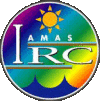User Tools
Sidebar
This is an old revision of the document!
Table of Contents
IPRT polarized radiative transfer model intercomparison
General conventions:
- For all cases normalized radiances are compared (i.e. Stokes vector components devided by the extraterrestrial irradiance).
- The viewing azimuth angle is defined clockwise
- The sun position is the position of the sun in the sky defined by solar zenith angle sza and solar azimuth angle saa. Note that the direction vector (vza, vaa) is then opposite to the solar beam travel direction (vaa = saa indicates that the sensor looks into the direction of the sun, vaa-saa = 180° means that the sun is in the back of the sensor)
- The output format is ascii, details are provided for the individual test cases
In order to check model definitions of signs of the Stokes vector and azimuth angles, you should first run only case A1.
Phase I - One-dimensional test cases
A - Test cases with one layer
B - Test cases with multi-layers
Publication: C. Emde, V. Barlakas, C. Cornet, F. Evans, S. Korkin, Y. Ota, L. C.-Labonnote, A. Lyapustin, A. Macke, B. Mayer, and M. Wendisch. IPRT polarized radiative transfer model intercomparison project – phase A. J. Quant. Spectrosc. Radiat. Transfer, 164(0):8-36, 2015. link
Phase II - Three-dimensional cases
Publication: C. Emde, V. Barlakas, C. Cornet, F. Evans, Z. Wang, L. C.-Labonotte, A. Macke, B. Mayer, and M. Wendisch. IPRT polarized radiative transfer model intercomparison project – three-dimensional test cases (phase B). J. Quant. Spectrosc. Radiat. Transfer, 209:19-44, 2018.link
Phase III - 1D spherical geometry
General conventions and settings
- Definition of angles for all simulations in spherical geometry: We refer to the angles at the position of the observer, i.e. at the top of the atmosphere VZA=θv' and SZA=θ0'. For the observer at the surface VZA=θv and SZA=θ0. The azimuth angles also refer to the position of the observer. The figure is taken from Gao et al. 2023.
- Results should be provided as normalized radiances (i.e. Stokes vector components divided by the extraterrestrial irradiance).
- For all cases except E6, the same sun-observer geometries should be calculated:
- viewing zenith angles (degrees): [0, 9, 18, 26, 34, 41, 48, 54, 60, 65, 70, 74, 78, 81, 84, 86, 88, 89, 90] (up-looking at bottom of atmosphere, down-looking at top of atmosphere]
- viewing azimuth angles (degrees): 0-180, 10 degrees increment
- solar zenith angles (degrees): [30, 60, 80, 87, 90, 93, 96, 99]
- solar azimuth angle (degrees): 0
- sensor altitude (km): 0, 120
D - Test cases for fully spherical geometry with one layer
E - Test cases for fully spherical geometry for a vertically inhomogeneous atmosphere
The results of all cases (D and E) shall be included in a single netcdf file using this template: iprt_phase3_XXX.nc.


